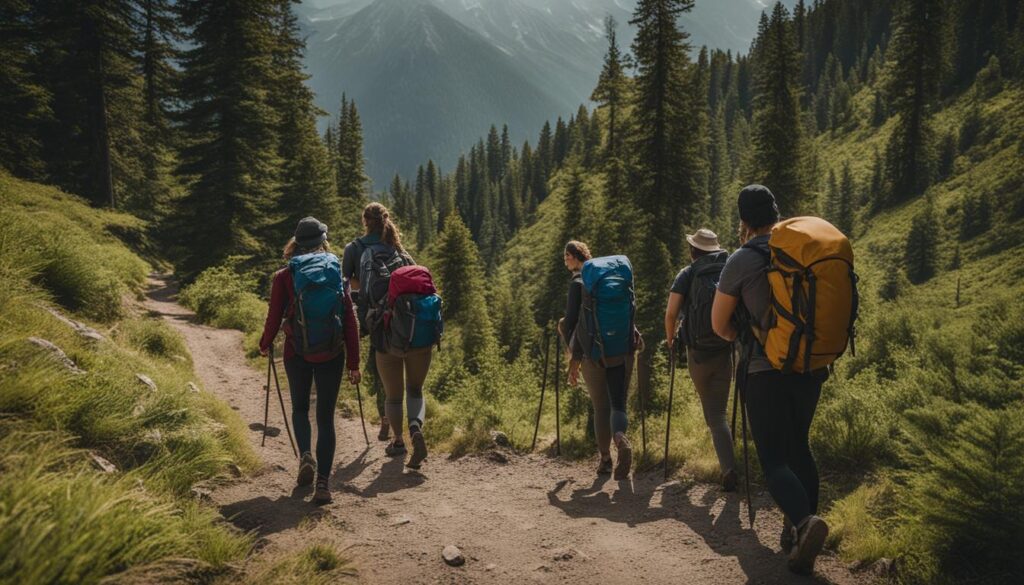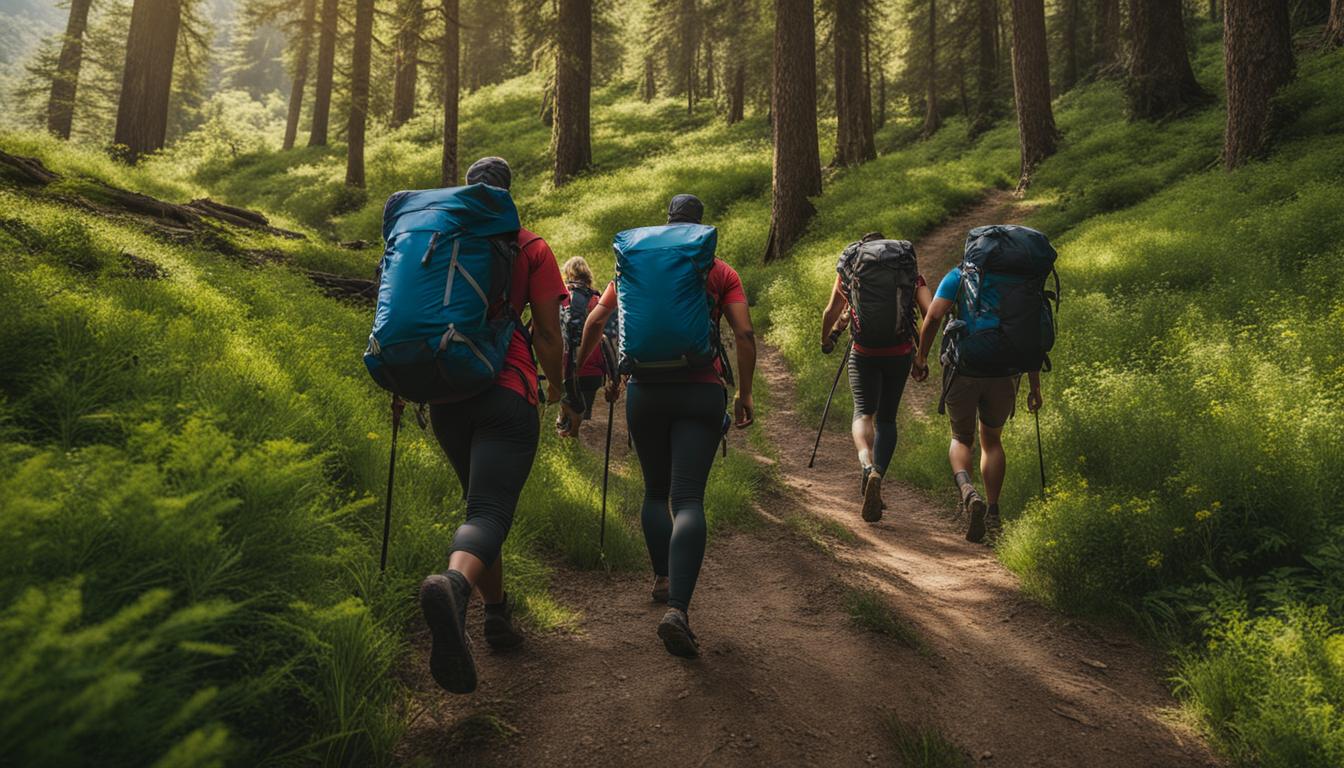Hey there! As an avid hiker, I’ve come to realize the importance of understanding and practicing trail etiquette. It’s not just about being polite, but also about respecting the outdoors and ensuring a positive experience for everyone on the trail.
When we follow trail etiquette guidelines, we promote a sense of respect for other trail users and stewardship of the land. It’s about being considerate, mindful, and responsible as we embark on our outdoor adventures.
So, let’s dive in and explore some essential trail etiquette practices that will help us make the most of our hiking journeys while preserving the beauty of nature.
Key Takeaways:
- Understanding and practicing trail etiquette is crucial for promoting respect and stewardship.
- Know your right of way on the trail and yield to others when necessary.
- Stay on the designated trail to avoid damaging the environment.
- Respect wildlife and give them their space.
- Be aware of trail conditions and avoid using muddy trails.
Right of Way on the Trail: Understanding Hiking Etiquette

When hitting the trails, it’s important to understand the right of way and follow proper trail etiquette. Whether you’re a hiker, runner, mountain biker, or dog owner, knowing the rules will ensure a safe and enjoyable experience for everyone.
Hiking Etiquette Rules
As a hiker, it’s crucial to yield to other trail users in certain situations. Uphill hikers have the right of way over downhill hikers. Since uphill hikers have a more narrow field of vision and are exerting more effort, it’s important to give them space and allow them to maintain momentum. When passing other hikers, announce yourself in a friendly, calm tone and let them know you want to pass. Practice good trail etiquette by stepping off the trail to the right, if possible, when yielding to other hikers.
Mountain Biking Etiquette
Mountain bikers should be aware of specific rules for interacting with other trail users. Bicyclists should yield to both hikers and horses, coming to a full stop and stepping aside to give the right of way. Rules may vary depending on the trail or park, so it’s essential to follow signage and specific regulations for biking. Remember, hikers and horses should always be given priority over mountain bikers.
Trail Etiquette for Dog Owners
If you’re hitting the trails with your furry friend, it’s important to be a responsible dog owner. Keep your dog on a leash and under control at all times. Follow the rules of dog-friendly trails and be mindful of other trail users. Not everyone may be comfortable around dogs, so it’s important to respect their space and be considerate of others on the trail.
| Trail Users | Right of Way |
|---|---|
| Uphill Hikers | Have the right of way over downhill hikers |
| Hikers | Yield to horses and other pack stock, calmly stepping off the trail to the downhill side |
| Mountain Bikers | Yield to both hikers and horses, coming to a full stop and stepping aside to give the right of way |
| Dog Owners | Keep dogs on a leash and under control, following the rules of dog-friendly trails |
Communication and Consideration: Interactions with Other Trail Users
When it comes to hiking etiquette, effective communication and consideration for other trail users are key. Proper interactions on the trail can help ensure a positive experience for everyone involved. Whether it’s passing other hikers, encountering mountain bikers, or engaging in small talk, following a few guidelines can go a long way in promoting harmony on the trail.
Passing on the Trail
Passing other hikers is a common situation on the trail, and it’s important to do so in a courteous manner. To ensure a smooth passing, consider using passing phrases to announce your presence and indicate your intention to pass on the left. A simple “Excuse me” or “Passing on your left” can be effective in avoiding surprises and maintaining a respectful distance.
It’s worth noting that uphill hikers may also request to pass other uphill hikers, but it’s generally considered polite to wait until the trail widens to avoid unnecessary congestion. Additionally, solo hikers and smaller groups should yield to larger groups, allowing ample space for easy passing.
Communication with Mountain Bikers
Trail encounters with mountain bikers require effective communication to ensure the safety of all parties involved. Mountain bikers should utilize calls or small bells to signal their presence to hikers. This gives hikers the opportunity to be aware of approaching bikers and move aside, preventing any potential accidents.
Moreover, engaging in small talk with other hikers can enhance safety and provide valuable information about trail conditions. Friendly conversations can foster a sense of community on the trail and lead to helpful exchanges of knowledge and experiences.
| Common Trail Etiquette Tips: |
|---|
| Use passing phrases to announce your presence and indicate your intention to pass on the left. |
| Wait for wider trail sections before passing uphill hikers. |
| Yield to larger groups as a solo hiker or smaller group. |
| Mountain bikers should communicate their presence to hikers. |
| Engage in small talk for safety reasons and to exchange trail information. |
By adhering to these simple guidelines and practicing common trail etiquette, hikers can contribute to a positive and enjoyable outdoor experience for all. Remember that effective communication and consideration for others are the cornerstones of responsible trail use.
How does Trail Etiquette Help in Respecting Wildlife and Nature?
When hiking or biking, following tips for respecting wildlife is crucial. Yielding to animals, staying on marked trails, and avoiding loud noises can minimize disturbances to wildlife and their habitats. Practicing trail etiquette not only keeps us safe, but also shows respect for the natural world around us.
Conclusion
Practicing trail etiquette is not only a way to show respect for other hikers and trail users, but it also helps protect the environment and enhances the overall hiking experience. By following a few simple guidelines, we can all contribute to maintaining a positive atmosphere on the trail and ensuring everyone’s safety and enjoyment.
Remember to always know and follow right-of-way rules, such as yielding to uphill hikers and horses. Keeping your dog under control and following specific rules for dog-friendly trails is also important. Effective communication with other hikers through polite phrases and small talk can enhance safety and provide valuable information about trail conditions.
Additionally, embracing the Leave No Trace principles is crucial to minimize our impact on the trail and preserve its natural beauty. This includes packing out trash, staying on the designated trail, and respecting rock cairns. By practicing trail etiquette, we not only leave the trail better than we found it, but also contribute to the enjoyment of future generations of hikers.
So, the next time you hit the trail, remember these trail etiquette tips. Let’s all do our part in respecting each other, the environment, and creating a harmonious hiking community. Happy hiking!

